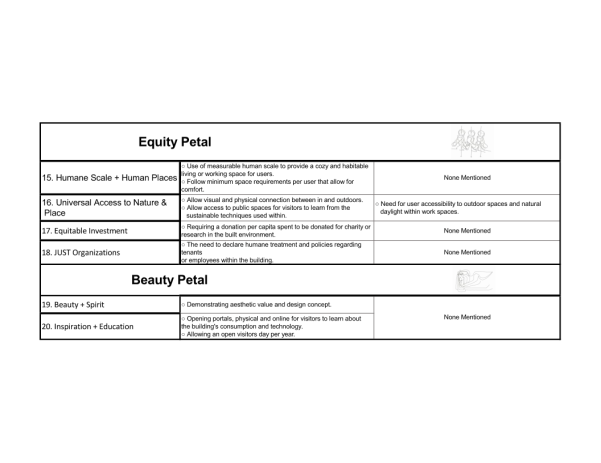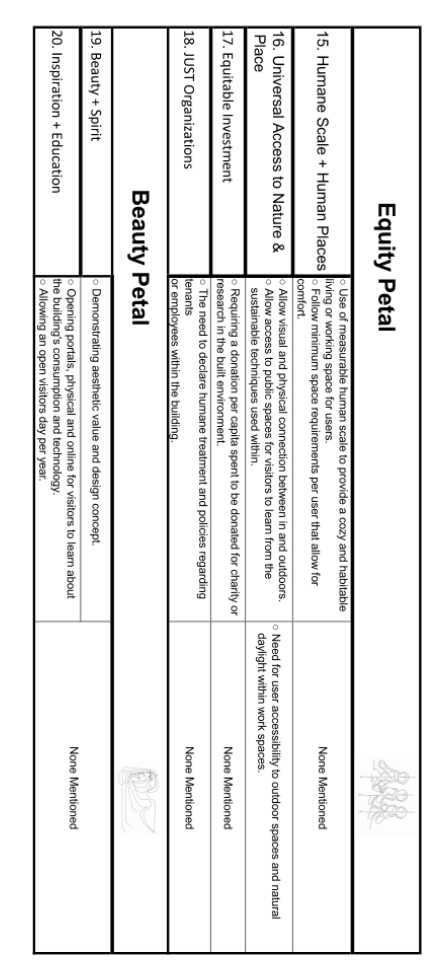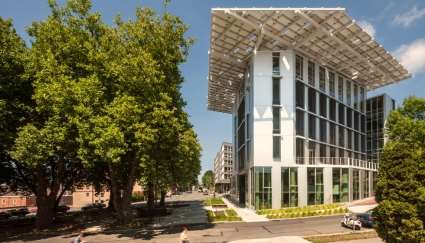Living Building Challenge & BREEAM: Non-Residential Building
| ✅ Paper Type: Free Essay | ✅ Subject: Architecture |
| ✅ Wordcount: 5457 words | ✅ Published: 28th Jul 2017 |
Rethinking the Application of the Living Building Challenge & BREEAM for Non-Residential Buildings in the UK
Building certification and assessment has been in spotlight since the rise of the concept of sustainable development, the need to improve building performance and reduce our consumption. Growing from a shared ideology of Jason F.Mclennan’s team, to create a utopian idea, the Living Building. One that has high potential for low running costs, high performance and user comfort, the epitome of the definition of sustainability. The living building challenge (LBC) was initially assessed by BNIM against the LEED standard upon its design, to determine its environmental and impact worth in a sustainable matrix. However, in this paper a cross case investigation between the LBC version 3.0 and BREEAM’s code for non-residential buildings 2011, will be undertaken to highlight each certification’s merits and shortages. Followed by a cross-case analysis of 2 case studies to reflect on the investigation’s results.
Get Help With Your Essay
If you need assistance with writing your essay, our professional essay writing service is here to help!
Find out more about our Essay Writing Service
This is in an attempt to highlight which of the assessment methods has more comprehensive and in-depth critical criteria, how it’s applied by drawing on lessons from the case studies available for study from the public domain, through the LBC and BREEAM’s online portals.
For years, the race to creating sustainable assessment tools has been on-going to counter a variety of challenges in people’s lives, countries’ resources and global wellbeing (Rees, 1999, Edwards et al., 2013). Problems in a national scale that include waste tackling, organic and non-organic, energy consumption, water both excess and depravity from it, Carbon Dioxide and greenhouse gas emissions, all of which contribute to national pollution statistics, waste and water treatment expenses and energy production (DEFRA, 2012) . The increase in these costs furthermore continues the cycle to affect the primary user, by raising energy prices for electricity, heating and cooling, county and city taxes and other government or privately provided services (Manne et al., 1991, ASIF et al., 2007).
While typical cities contributes to an average of 75% of greenhouse gas emissions according to United Nations Environmental Programme (UNEP, 2014), commercial structures and transportation account for 16.25% and 25% of the United Kingdom’s (UK) energy consumption sectors(Department of Energy, 2014, p. 12) . In addition to 38% of the country’s overall energy sinks being accounted towards energy generation, 83% of which is generated through coal power plants, the primary electricity generation method in the UK (Department of Energy, 2014, p. 12), contributing a large emission rate of 0.507 kg CO2/kWh (DEFRA, 2008). Whilst the housing sector remains the dominant sector, but commercial buildings have been on a rise, to accommodate for different functions, educational, retail, offices and learning institutions. (PMRecon, 2013). The construction sector is in a strong boom (Longworth, Kern and Marshall, 2014), along with construction emissions such as material sourcing, material fabrication, and the building’s operation itself.
This paper will be addressing two case studies from the commercial office buildings sector of the construction industry: The Bullitt Center (LBC) and the. Addressing the strategies implemented within each, how each criterion was addressed and the impact on overall performance of the building.
In the United Kingdom, the Building Research Establishment (BRE), alongside its assessment tool, the BRE Environmental Assessment Methodology (BREEAM) have formulated a number of schemes to tackle different building types, including but not limited to, BREEAM, BREEAM for commercial buildings, and BREEAM for Sustainable Homes (EcoHomes previously).
The Living building challenge is a rigorous assessment tool created and published by Jason F.Mc Lennan and his associates, a project started from the mid-1990s and first coming to light in August 2006. The Living Building Challenge adopts a restorative nature, one that aims to give back to the environment (Warner, 2015). This paper will approach one of the more rigorous certification tools claimed to be applicable to any building type,). By having a net positive strategy, the building creates an excess of its needs, for storage or if possible to be input into nature as a metaphorical tax for trespassing on it (Monbiot et al., 2007). There’s a range of a 100 or more full living certified buildings around the world, the larger percentage being in the USA where the certification resides (ILFI, 2015) . However public record only shows buildings classified as non-private so the numbers can easily be more than that. And there’s even a larger amount of partially or petal certified buildings and projects (ILFI, 2015) .
. Any one building can acquire a number of certifications, relevant to each individual petal. However if a building is certified within all criteria, it gains a Certified Living Building Certificate, considerably the highest award given by the LBC.
Followed by individual petal certified buildings, these are structures that have satisfied one or more of the petals, and are most likely awaiting a final audit to be fully certified. The final certification is Net Positive Energy certification, requiring the building to have provide more electricity than calculatedly needed. To achieve net positive energy over course of the year, energy efficient features, electricity generation and passive design are employed.
In each section, an analytical and comparative summary of both the LBC and BREEAM will display how each standard addresses the named criterion. It is notable that due to the highly comprehensive nature of the LBC, BREEAM will be compared against the LBC’s petals and using the standards and descriptions provided under the LBC’s handbook. With the end of each petal, and summarizing this section, the author will conduct a summary comparative analysis between both standards, listing in brief, how each addresses the topics and providing analytical insight into the results.
The LBC uses a number of concepts to guide its users through the design and certification process, the terms are derived from various sources, references or the creators own research to construct a logic space through which this tool operates.
Typology: Typology refers to the scope and type of project being conducted, this helps identify what imperatives are compatible and can be applied to the project.
 Renovation: This refers to any project that is not a complete building on its own, but part of a previous building as an addition or rehabilitation of historic or old structures.
Renovation: This refers to any project that is not a complete building on its own, but part of a previous building as an addition or rehabilitation of historic or old structures.- Infrastructure + Landscape: This refers to projects that operate on an open scale, such as parks, amphitheaters, or other civil projects such as public plazas, exercise fields, bridges and so on.
- Building: This refers to projects that involve whole buildings both ones already existing and to include renovations or new ones all together.
- Community: The community challenge applies to a number of structures that coexist together and operate as part of a neighbourhood, community, campus whilst sharing certain amenities such as, but not limited to, roads, green or community areas.
 Transect: The transect concept is an adaptation of the New Urbanism transect planning approach that was developed and published in the Smart Code manual (latest version 9.2) by the Center for Applied Transect Studies (CATS, 2010). The transect smart code benefits from and adapts Smart Growth and New Urbanism strategies into creating a well divided yet adequately mixed community that supports sustainable growth for community, nature and urban development (Duany, Plater-Zyberk and Company, 2009). In the living building challenge, adequate transects for each project must be identified according to footprint and site scale in order to adapt the appropriate imperatives to suit the site as such that it is developed to be a productive part of its context.
Transect: The transect concept is an adaptation of the New Urbanism transect planning approach that was developed and published in the Smart Code manual (latest version 9.2) by the Center for Applied Transect Studies (CATS, 2010). The transect smart code benefits from and adapts Smart Growth and New Urbanism strategies into creating a well divided yet adequately mixed community that supports sustainable growth for community, nature and urban development (Duany, Plater-Zyberk and Company, 2009). In the living building challenge, adequate transects for each project must be identified according to footprint and site scale in order to adapt the appropriate imperatives to suit the site as such that it is developed to be a productive part of its context.
Whilst that approach allows for a natural flow of urban development, imposing guidelines that regulate form without function on a city scale causes complications, specifically when applied on a regulatory scale, some documents might be too technical and complicated as to negate architectural design creativity and hinder functions that occupy these buildings. (Garnett, 2013, pp. 571 – 588). Fortunately within the Living Building Challenge, these concepts are not strictly applied, but are merely regulated in the latest addition in version 3.0 stating that buildings needs to adapt beauty and reflect on their context, but stated exceptions due to local regulations are allowed.
 Scale Jumping: In case the project’s place petal amenities require space larger than required or there is potential for cooperation, it is possible to scale jump these areas as long as they serve more than one building or site, and as long as they’re off the main project zone.
Scale Jumping: In case the project’s place petal amenities require space larger than required or there is potential for cooperation, it is possible to scale jump these areas as long as they serve more than one building or site, and as long as they’re off the main project zone.
Colour coding in the next section will be used to mark the start of paragraphs marking ones that include Living Building Standard to differentiate them for the ones comparing with BREEAM.
The Living Building Functions as a Certification, accompanied with a guidance manual, used to achieve named certification. It classifies the different categories within to a series of broad umbrellas, or Petals. Each petal is composed of a number of relevant criteria, named imperatives. The LBC’s categories are divided into seven petals, which encompass a set of comprehensive criteria, the acceptable methods and parameters needed to achieve them.Â
The Petals summarized into the following table reflects the Living Building Institute’s vision into the main categories that should be addressed to achieve a comprehensive regenerative design according to the LBC’s vision:
|
Place |
Net Positive Water |
Net Positive Energy |
Health & Happiness |
|
Materials |
Equity |
Beauty |
Whilst the set of Petals assigned by the LBC might be considered of a wide scope, it is however a certification and not a technical standard, thus by comparison, BREEAM encompasses more sections, which are different arrange by marginally align with the components within the LBC.
|
Management |
Health and Wellbeing |
Energy |
Transport |
Water |
|
Waste |
Land Use & Ecology |
Pollution |
Innovation |
Despite the larger number of sections, items such as Land Use, Ecology and Transport are embodied within the Place Petal. Waste is segregated and included within the Water and Materials petals, pertaining to organic waste, food waste and construction components. Pollution is divided across all petals, and emphasized within Health & Happiness, Place and Materials petals to regulate pollution within surrounding and indoor environments. Finally given the LBC’s transparency policy, it sponsors a system of declaration and comprehensive calculation and checks regarding each Petal from design to end of life, thus concluding with the Equity and Beauty Petals which are no included within the BREEAM, yet left open ended within the LBC.
I. Place Petal
The place petal, formerly the Site petal, is the first of the set, it relates to the project’s setting, its site, surroundings, ecology and is concerned with placing the building its appropriate surroundings. The petal addresses all projects despite scale, surroundings or function, the designer, or design team as stated must work into defining the site appropriately to understand how to protect the site’s ecology and restore it post-construction. The Place petal is heavily affected by each site’s Living Transect assigned to it, project area or scale jumping and thus the petal guidebook has been rigidly assigned to ensure that all calculations and certifications have been unified. The place petal includes 04 Imperatives, listed briefly;
|
Limits to Growth |
Urban Agriculture |
|
Habitat Exchange |
Human-Powered Living |
The Imperatives within the Place Petal, as previously mentioned are comparable to some of the criteria listing under the Transport, Ecology and Site sections within the BREEAM documentation. Enforcing the regenerative nature of the LBC, this petal sponsors a strategy of ecological preservation and rehabilitation as a result of human activities. All of which is sponsored by BREEAM however not enforced as rigidly nor is it mandatory, except for the Habitat Exchange petal, reflected in LE 03, minimizing impact on existing ecology. However, it does not enforce a requirement for a net zero or net positive impact on the environment, but rewards based on reducing the negative impact on the environment between a negative to net zero range.
Briefly summarized, the comparison between both sets of regulations takes a positive stand against ecological decay, requiring the maintenance of local ecology and further development, not simply the mitigation of any further damage or simply reducing the damage caused. Whilst on a small scale, it would benefit local ecology, this strategy has to be employed on a wider scale to start mitigating or reversing global decay of natural environments.
However, the lack of exact calculations that would measure the effect of any construction in any existing ecosystem of high or low value, makes it essential that the LBC needs other regulatory systems and assessment tools to supplement and optimize its performance. It is apparent that the application of this section requires the expertise of an ecological specialist for both systems, and would be high in cost. Ultimately as the LBC is a restorative system, it remains important to perform this task as part of the metaphorical price of intruding on nature.
In addition, addressing the Transport section of BREEAM, reflected within Human powered living and the Transects concept of the LBC. The LBC encourages walkable communities, the use of bicycles and non-engine operated modes of transportation with the more populated transects, restricting use of cars to commute in and out of these zones. In addition, it requires estimating the need for storages and car parks based on demand, providing accessibility for mobility and the use of human powered transport and finally. Apart from the effect of that policy on pollution, it does reduce the carbon and energy cost of transportation, such as commute and food miles and ultimately promotes awareness and healthy lifestyles. BREEAM while advocating similar requirements, also adds the needs for compact urban design, to reduce the need for modes of transportation, rather than regulating these modes of transportation. In summary, the need to address users’ needs for storage, distances and methods of commute is imperative to reducing the overall pollution and energy impacts of the residing community.
Finally, and exclusively required by the LBC, enforcing a policy of urban agriculture, reducing food miles and a policy to encourage food storage within households sets the LBC apart. One can criticize however that the requirements of farmable land per building footprint are disproportionate to the density of users occupying it and would need to be rectified to meet realistic expectations.
II. Water Petal
The water petal governs the production, use and disposal of all fluid and water based materials on site, including potable water, grey water, black water, storm and rainwater harvesting, managing it, storage and disposing of the excess.
The water petal only contains one imperative, which is an update from net zero water in version 2.1 to be Imperative 05. Net Positive Water in version 3.0 (LBI, 2015g). In brief, the Net positive water imperative advocates the compatibility between water systems on site and natural water systems depending on site and climate. It states that any water used on site must be part of a closed loop system where all used water must be captured on site by means of precipitation, rain or storm water collection, grey water treatment or ground water supply if possible. Of course exceptions are made in case of extreme climatic conditions where it is not feasible or where the natural supply cannot satisfy consumption due to user capacity, where an appeal can be made given proper support. In comparison, BREEAM has Wat01-Wat04 criteria (BRE, 2014),, only Wat01 that specifies water consumption is mandatory, with a minimum performance of providing 12.5% of water consumption within the building through closed loop methods and a maximum five credit score for providing 55% or more of consumed water in the building.
Similar to BREEAM Wat02 criterion (BRE, 2014), the LBC Water Petal requires monitoring of use constantly over the year, month by month and in detail. Unlike and in a stricter approach than BREEAM however, the water monitoring process is rigid and highly detailed, requires documentation of all production, use and sinks of water in the structure (LBI, 2015g). It also promotes the jump scaling of this imperative to benefit the community, where a cistern or a unified water storage can be shared between multiple sites, the community, ecosystem or agricultural land.
Concluding the water petal, due to England’s Koepen-Geiger climate zone being Cfb, one that has an average of 800mm annual rainfall during the whole year (World Maps of Köppen-Geiger climate classification, 2010, Kottek et al., 2006, pp. 259-263), applying an efficient water harvesting strategy would not be a difficult challenge, the problem would arise with treatment and storage specially on smaller sites, which in turn creates opportunities for jump scaling and providing neighbourhood benefit.
III. Energy petal
Just like the Water Petal, managing resources in the Living Building Standard have taking a developmental step towards net positive, thus as an upgrade from v2.1 of the Energy Petal that advocated Net Zero energy to the new Energy Imperative 06. Net Positive Energy (LBI, 2015a).
In summary, the new Net Positive imperative calls for the production of one hundred and five percent (105%) of the project’s energy requirement are satisfied on site by sustainable and renewable energy methods on a net annual basis. What adds to this petal’s challenge, is the need for resilience, the requirement to store energy for emergency in addition to night-time use. The resilience component requires a minimum of 10% of essential lighting load and refrigerator operation for up to a week (LBI, 2015a). A formidable challenge in England; due to the low number of sunny hours annually, reaching an average of 1493 hours of sun per year (Current Results Weather, 2015) making the return to solar origins concept adopted by LBC a solution that might not be entirely financially viable.
What sets this strategy apart from other assessment methodologies is the prohibiting of combustion, burning of any material, biomass, biofuels, alternative or conventional fuels due to the possibility of harmful gas emissions, as well as the release of greenhouse gases despite how efficient the combustion module is (McLennan, 2010).
On the other hand, BREEAM does not ban the use of combustion energy sources, but relies on the relationship between energy use and Carbon Dioxide emissions, which release nitrates and carbon compounds that account for global warming (Johnson, 2009, pp. 165-168). BREEAM aims for a zero carbon approach, with potential for Carbon Negative buildings acting as sinks. Both systems require a twelve-month monitoring period to determine the building’s efficiency when occupied. However, given the author’s current research, it is likely a performance gap may be observed due to human use discrepancies that were not accounted for using Standard Assessment Procedure (SAP), and are not adequately measured using the LBC’s online calculators.
IV. Materials Petal
The materials petal aims to create a future of materials economy that is non-toxic, regenerative and avoid any negative effects on occupant’s health, the material petal aims to use materials that can be re-used while eliminating the concept of construction waste while staying financially viable, functionally efficient and aesthetically pleasing (LBI, 2015c). Due to production costs, sourcing, transportation distance and the general economy, sourcing these materials remain to be a challenge, but the LBC attempts to counter that challenge by creating a guideline to follow that will allow achieving its targets without any negative impacts. The materials petal has been put ahead of the Health & Happiness Petal since the outcome of an adequate material petal certification will lead to the final outcome of Health and Happiness.
The Material petal is composed of five imperatives that will be briefly discussed and critically compared to the BREEAM’s six material criteria and six waste criteria, both of which are grouped under the Materials Petal in a brief yet comprehensive guideline. The five imperatives are listed as follows,
|
Red List |
Embodied Carbon Footprint |
Net Positive Waste |
|
Responsible Industry |
Living Economy Sourcing |
Imperative 10. Red List advocated the elimination of “worst-in-class” materials and chemicals as it dictates, ones with the greatest negative impact to occupant and ecological health. The list includes a large number of petroleum products, polymers and compounds that contribute to volatile organic compounds (VOCs) spreading in construction as well as other harmful chemicals that lead to a number of physiopathological mechanisms, respiratory diseases and disorders they might cause to occupants (Fernández et al., 2013, pp. 22-27) including but not limited to symptoms such as irritations, coughing and respiratory symptoms, nervous symptoms such as headaches and fatigue, dry skin and other symptoms users might take for granted or under-estimate to be prompt yet prove even more harmful on the long run (Wolkoff, 2013, pp. 371-394). BREEAM recognizes the dangers of these materials, and allows their use under certain conditions according to its own tables and conditions under its health and wellbeing section HEA02- Indoor air quality. BREEAM tackles the problem of VOCs (BRE, 2014) by running a pre-occupancy test after end of construction to determine the concentration of contaminants in the structure, and if found within the appointed limits, it grants the points.
The C2C methodology is ambition, but calculation methodology does not include energy that goes into rehabilitating that product for reuse, neither does it account for the quality of the product and ability to function adequately (Bakker et al., 2010). Energy input into the different stages of product development, such as transportation which accounts for 90% of some appliances (Llorach-Massana et al., 2015). It is however calculable and would allow for a deeper understanding of the building’s energy and carbon impact by calculating a complete building life cycle from cradle to cradle (Braungart, McDonough and Bollinger, 2007, pp. 1337-1348).This would assess the carbon impact of the building from inception to deconstruction and potential reuse. (Kneifel, 2010, pp. 333-340, Bribián, Capilla and Usón, 2011, pp. 1133-1140).
Imperative 12. Responsible Industry and Imperative 13 Living Economy Sourcing and Net Positive Waste are related when it comes to the overall concept, both imperatives call for sustainable, local or national and proper sourcing of materials. Processing has to be transparent and declared, sources from sustainable or renewable sources dedicated for farming or reclaimed through cradle to cradle or recyclable schemes in addition to some materials also known as Carbon Leaks and Carbon Exports (Davis and Caldeira, 2010, pp. 5687-5692, Kuik and Hofkes, 2010, pp. 1741-1748).
However, the use of this concept in the UK might be hindered due to limited resources and would extend to the European Economic Area alongside consideration for the expenses and emissions produced by importing.
V. Health and Happiness Petal
The last of the published petal handbooks set in version 3.0, containing imperatives 07 to 09, listed as follows
|
Civilized Environment |
BioPhillic Environment |
|
Healthy Interior Environment |
(LBI, 2015f) This set of imperatives work to provide a psychologically and physically healthy environment for occupants and owners, by creating connections to the surrounding environment (Coon et al., 2011, pp. 1761-1772) and designing and specifying healthy indoor materials.
Imperative 07. Civilized Environment and Imperative 09. Biophillic Environments both share common grounds that contribute to psychological and physical health (LBI, 2015f). Both imperatives aim to create a direct connection between indoors and outdoors, a feeling of visual and a level of physical continuity to provide a feeling of joy and freedom (Ching, 1995). Achieving these targets; by performing adequate daylight calculations to identify any glare spots and daylight distribution without spaces, allowing sufficient daylight factors within the building (Roche, Dewey and Littlefair, 2000, pp. 119-126), in addition to accounting for thermal and visual comfort (Greenup, Bell and Moore, 2001, pp. 45-52), creating connections with the outdoors is an essential requirement in imperative 07 without any possible appeals except for areas of special use or areas that are not frequently occupied.
BREEAM had managed to shed a stronger light when it comes to health and wellbeing criteria, by setting rigorous standards for ventilation, daylight factors and ratios and indoor quality (BRE, 2014). It also adopted criteria to provide comfortable acoustic and thermal environments as well as security for its occupants (Novak, Treytl and Palensky, 2007), despite not being mandatory, these criteria do improve user comfort and satisfying them contributes to outstanding credits.
VI. Equity Petal
The Equity petal (LBI, 2015f), introduced in version 3.0 has limited literature, only introduced in the standard guidebook summarizing the latest version, it includes a table of design guidelines needed to be met or complimented to provide a sense of equality and justice between all users of the project, at any scale, but mostly focused towards the public and living community challenges. This petal is divided into four imperatives and will be briefly described, since they are still under development with no comprehensive guidebooks and are still quite subjective in approach, they will not be given great focus.
The petal guidelines tackle issues such as areas, distances, landscape and urban design to give users and pedestrians a sense of worth in surroundings modelled after the human scale and dimensions (Ching, 1995)/ Access to place allows general public usage of spaces created within projects to spread the benefit and eventually awareness to the project and value. Both advocate facilitated access to impaired users, allowing equal opportunities for all users (Thapar et al., 2004, pp. 280-289),
Imperative 17. Equitable Investment and Imperative 18. JUST Organizations, both of these imperatives tackle the humane side of building occupancy and donation towards charitable causes. It also includes the need for consideration of users, their needs and humane treatment.
VII. Beauty Petal
Last of the version 3.0 newly added petals, contains two imperatives; Imperative 19. Beauty + Spirit and Imperative 20. Inspiration + Education, both of which cannot be empirically calculated and proven (LBI, 2015f), thus documentation of design literature and efforts made to raise awareness of technologies have been, which reflects on the innovation standard in the BREEAM. However aesthetic value has not been regarded in BREEAM leaving that particular point out, which could be implied given that it is a technical tool for building performance not architectural design.




This section will discuss a cross case analysis between two case studies. Each reflecting one of the discussed assessment systems, the LBC and BREEAM. The author found it fitting that due to the main showcase of the LBC reflected in educational buildings, ones that have been developed to be a display and case study for LBC teams, that the cross case analysis would be best done across educational buildings of a similar scale. The LBC case study is an office and commercial complex, commissioned by the environmental protection foundation, the Bullit Foundation. The BREEAM case study is a building of a similar typology, a commercial and office complex, slightly larger in area and a BREEAM Excellence building, the Exchange in  street.
Commissioned by the Bullit foundation, an environmental agency with a mission to safeguard the Pacific North West’s ecology from non-sustainable and invasive human activity and raise awareness to the ecological issues that surround the region’s urban sprawl.
The building was commissioned under what they believe is the most rigourous standard, that would stand to raise awareness and work as a teaching experience for designers, professionals of the built environment and researchers. It’s a commercial office building, with space for various office tenants and a commercial space.

The Living Building Challenge is a powerful tool that might hold a number of innovative and important keys towards true sustainability. But due to the vast number of topics covered by it, the LBC requires supporting technical regulations created by local authorities to be applied to differ
Cite This Work
To export a reference to this article please select a referencing stye below:
Related Services
View allDMCA / Removal Request
If you are the original writer of this essay and no longer wish to have your work published on UKEssays.com then please click the following link to email our support team::
Request essay removalRelated Services
Our academic writing and marking services can help you!

Freelance Writing Jobs
Looking for a flexible role?
Do you have a 2:1 degree or higher?
Study Resources
Free resources to assist you with your university studies!


